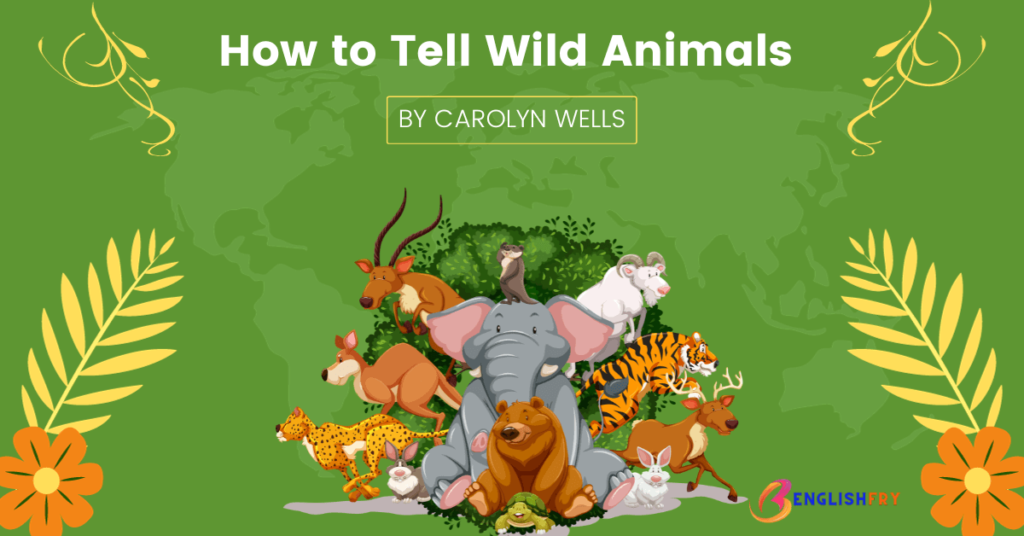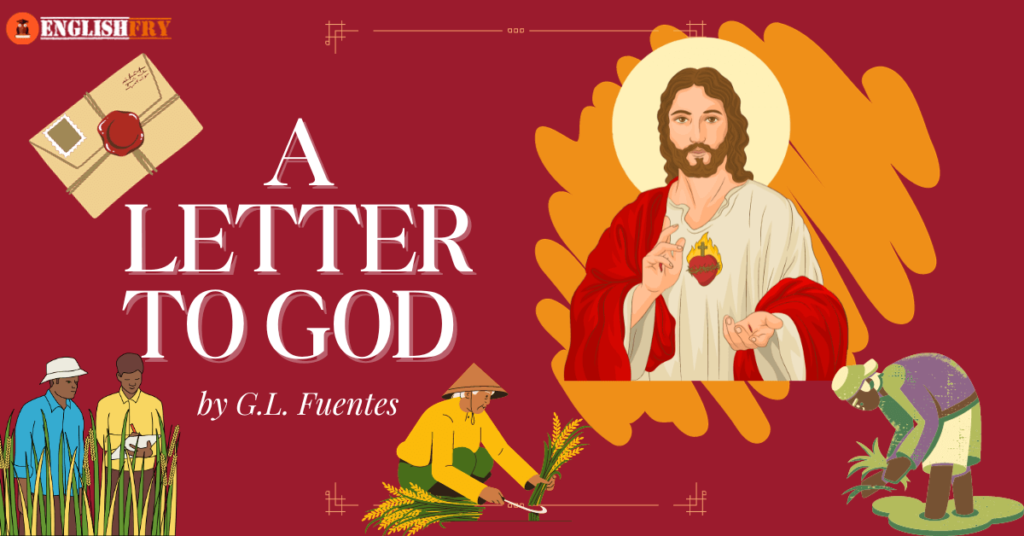Table of Contents
ToggleAbout the author Carolyn Wells
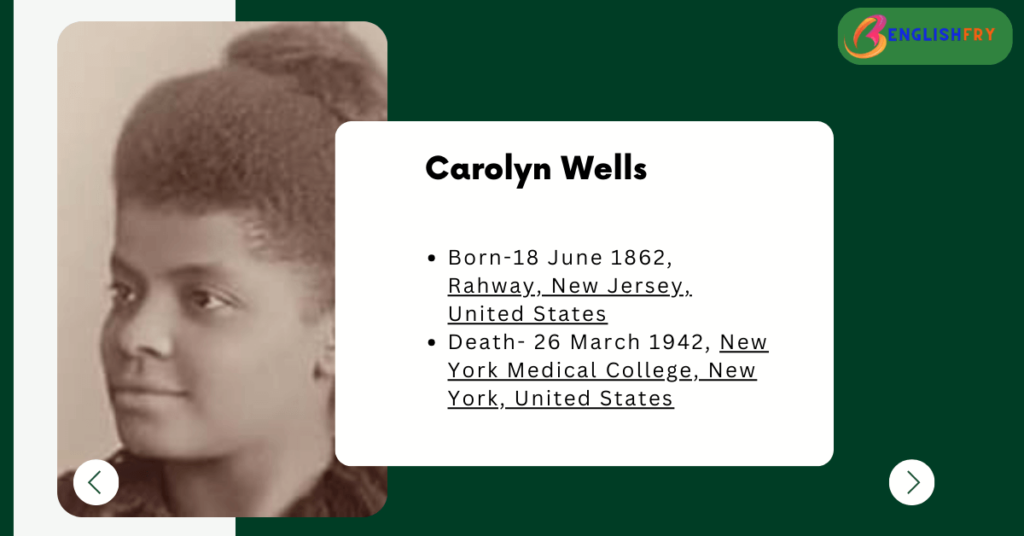
Carolyn Wells (1862 -1942) was an American mystery author and humorist. She suffered a hearing loss after suffering from scarlet fever at the age of six. She was an avid reader and took up the job of a librarian before becoming a full time author. Initially she wrote poetry, humorous verses and children’s books and then moved on to mystery novels. She wrote 170 books many of which were made into movies. Some of her famous works are ‘ The Countess Charming’, ‘Woman Next Door’, ’A Nonsense Anthology’ and ‘The Book of Humorous Verse’.
How to tell Wild Animals Stanza Wise Summary
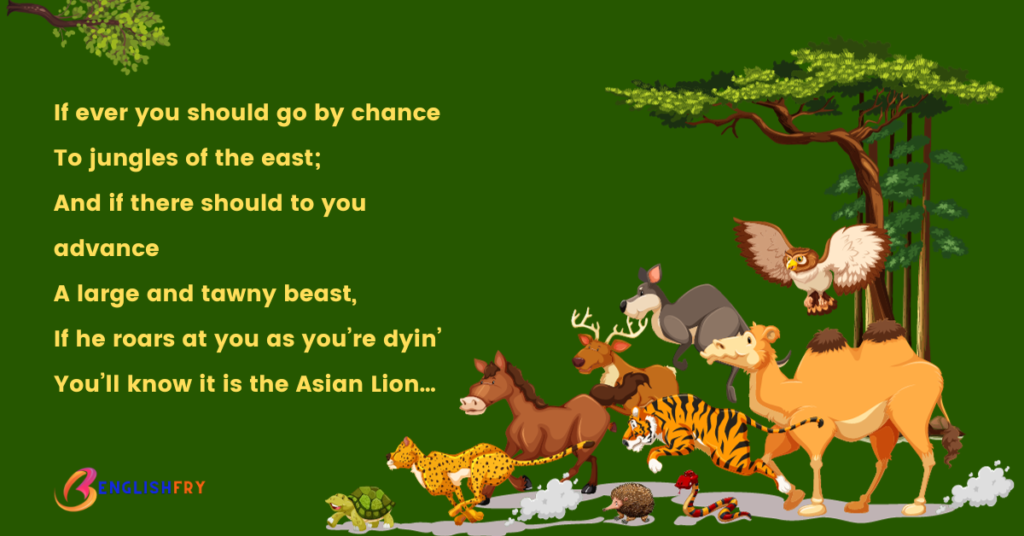
In the first stanza of the poem the poet is telling us that how we can identify a Asian lion. If ever you go to the jungle or forest in the east, you are likely to encounter a large and terrible yellowish brown animal moving towards you. Than you will notice that large beast roars loudly at you and when you’ll feel that you’re dying out of fear then you’ll know you met the Asian Lion.

In second stanza, the poet describes a royal yellowish skin animal having black stripes roaming freely in the jungle. The poet says one will be certain that it is a Bengal Tiger if he starts eating you. But now there is no point in identifying a wild animal if you have to die to know him.
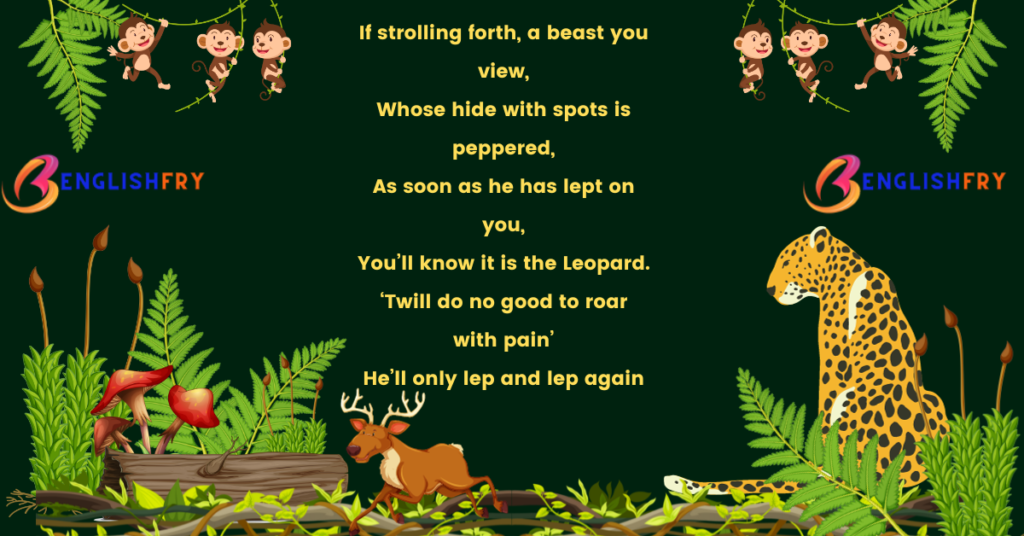
In this Third stanza, the poet says if we spot a creature with a speckled hide leaping at us in the forest, that’s our cue – it’s the Leopard. No need to bother yelling in pain; the leopard will keep leaping at you. So, exercise caution when encountering this spotted hunter.

In this fourth stanza, the poet says if you are walking in your yard of field and you see an animal and when that animal hugs you very tightly, the without any kind of doubt be sure that it is a Bear. The poet further says that if still you’re not clear you have doubt you can confirm it if he hugs you again.
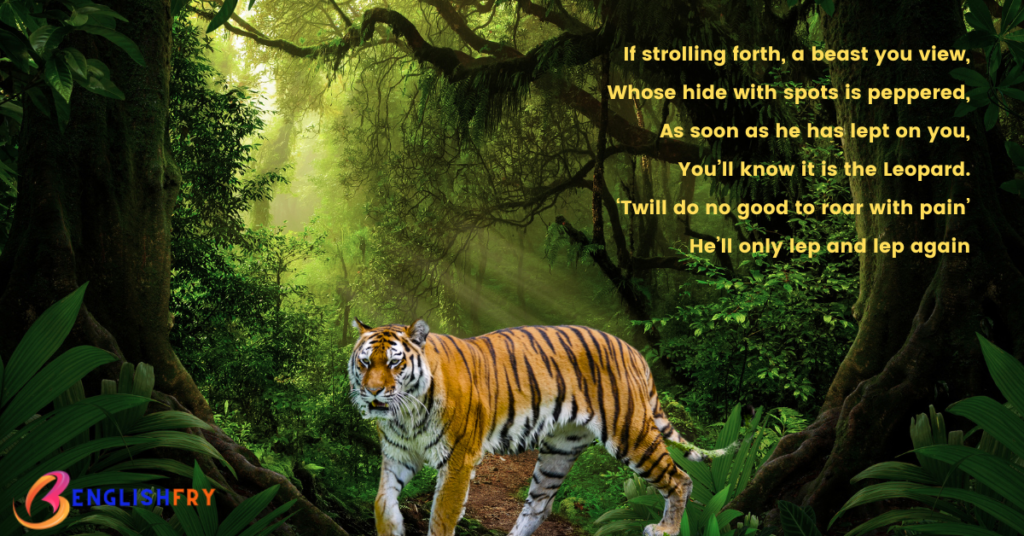
In this fifth stanza, the poet tries to differentiate between the Hyena and the Crocodile on the base of hunting of their prey. The poet says that a Hyena smile when they kill or swallow their prey. The laughing sound of hyena resembles human laugh. Similarly, Crocodiles shed they have tears in their eyes when eat their prey.

In the last stanza, the poet tries to describe a Chameleon a small reptile that naturally change its skin color. This small Chameleon looks like a Lizard but it does not have any ears or wings. When there is nothing on the tree at that time you can see this little Chameleon. The ability of Chameleon to change its color help him to be safe from the hunters and various animals as they can’t find him when he change his color.The authentic Chameleon is a petite lizard-like creature. It lacks ears and wings, and when you find nothing on a tree, that’s when you spot the Chameleon. Its remarkable ability to change color helps it stay hidden from hunters and other animals.
| Word | Meanings |
|---|---|
| Tawny | of Brownish- Yellow |
| Roam | To wonder |
| Discern | To detect or recognize |
| Strolling | to walk in slow relaxed way |
| Caress | To fondle, to kiss |
| Novice | Beginner |
| Chameleon | A kind of small lizard |
| Nonplus | Confused, Nervous |
| Lept | To jump one thing to another |
| Beast | A large animal |
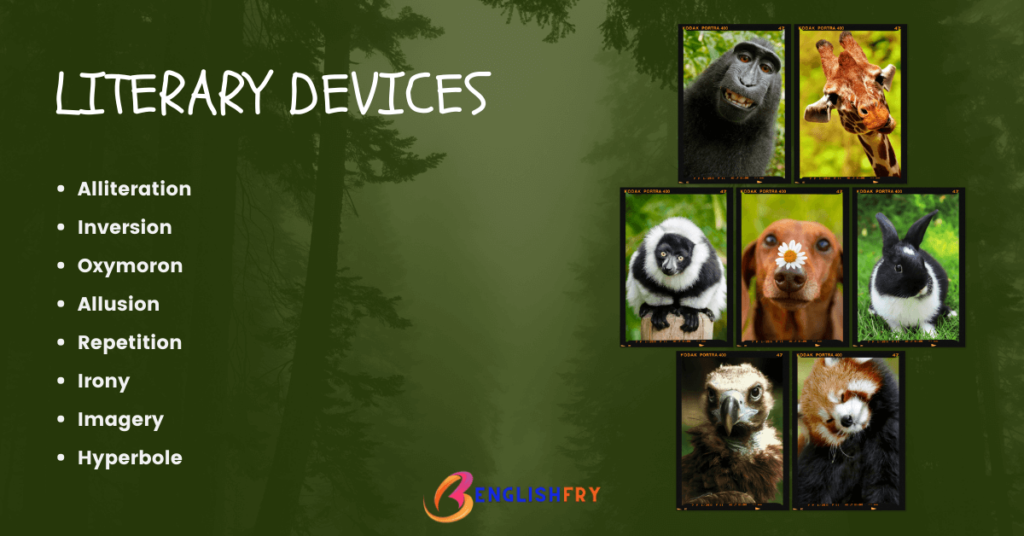
How to Tell Wild Animals Literary Devices
Alliteration – Repetition of consonant sounds in closely connected words
Roaming, round – ‘’r’ sound is repeated.
‘lep and lep again’ – ‘l’ sound is repeated.
‘Your yard’ – ‘y’ sound is repeated
‘He hasn’t’ – ‘h’ sound is repeated
‘at all’ – ‘a’ sound is repeated (assonance)
‘Be sure… bear’ – ‘b’ sound is repeated
Inversion – changing structure of a sentence
‘And if there should to you advance’
‘The Bengal tiger to discern’ – To discern a Bengal tiger
Oxymoron – juxtaposition of contradictory words
Noble wild – noble and wild are opposite characteristics
Allusion – direct or indirect reference to a thing
Asian lion
Bengal tiger
Repetition – repeating the same word for the sake of emphasis
Lep and lep
Very, very hard
Poetic license – freedom of the writer to ignore usual rules.
‘dyin’ – dying
‘lept’ – leapt
‘Twill – it will
‘Lep and lep’ – leap and leap
‘A novice might nonplus’ – a novice might be nonplussed (newcomer might be confused)
‘Tis’ – it is
Irony – use of word to mean something else. Usually opposite of what is stated
‘Caress’ – actually the hug will kill you
Imagery – using word to create visual image or sense impression
‘black stripes on yellow ground’
‘Whose hide with spots is peppered’
Paradox – Juxtaposing contradictory statements
If there is nothing on the tree,
’Tis the chameleon you see.
Hyperbole – exaggerating a statement to make it comical.
‘A noble wild beast greets you,’
‘If there is nothing on the tree’
How to Tell Wild Animals Question and Answers
Question 1.How can you identify the Asian lion and the Bengal Tiger?
Answer:The Asian Lion has a large body and a brownish-yellow
coat. It roars loudly when it attacks it’s prey. On the other hand, the Bengal Tiger has black stripes on its yellow coat. It silendy attacks it’s prey.
Question 2.Write the sum and substance of the poem, “How to Tell Wild Animals”.
Answer:The poet, Carolyn Wells, in the poem suggests some of the dangerous ways to identify the wild animals. The poem is full of humorous examples when the poet tries to distinguish one animal from the other. Moreover, the poem educates us by describing the various features of wild animals.
Question 3.How can you distinguish between a tiger and a leopard?
Answer:A tiger has black stripes on its yellow coat. A leopard on the other hand, does not have any stripes. It has spots peppered on its body. Moreover, a tiger kills only when it is hungry, while a leopard can kill for the pleasure of killing by pouncing continuously on its prey.
Question 4.How can you distinguish between a hyena and a crocodile?
Answer:A hyena laughs as it swallows its victim, whereas a crocodile weeps as it swallows its victim.
Question 5.What are the distinctive features of the Asian lion as given in the poem?
Answer:The Asian Lion is large in stature. It is brownish-yellow in colour. It roars very loudly. The sound of its roar is so terrible to hear that it can make one almost die due to fear. The Asian Lion is found in the forests of East Asian countries.
Question 6.What does the Bengal Tiger look like? What is so distinct about him?
Answer:The Bengal Tiger roams freely in the forest. It is noble and majestic in stature. It wears black stripes on a yellow hide. When it notices someone it tries to eat him. The Bengal tiger attacks its prey very silently and grasps it with his terrifying teeth.
Question 7.How does a leopard behave when he sees someone?
Answer:As leopard has black spots all over its body. As soon as it sees someone, it leaps over him at once. It keeps on pouncing continuously on its victim, attacks him and starts eating him.
Question 8.How does the poet describe the bear?
Answer:The poet describes the bear in a humourous way. He says that as soon as a bear sees a human being, it hugs him tightly. It clasps its prey tightly with both its hands and squeezes him to death. If he is still alive, he gives him another tight hug to kill him.
Question 9.What is so weird about the Hyena and the crocodile?
Answer:Some animals such as the hyena and the crocodile are famous for their weird behaviour. For example, a laughing hyena’s voice resembles human’s laughing sound. Moreover, a hyena laughs while swallowing it’s prey, while a crocodile shed tears.
Question 10.Describe a few characteristics of a chameleon.
Answer:A chameleon is a garden lizard and is an expert at camouflage. It changes its colour as per its surroundings. This ability of camouflage helps it in saving it from the hunters. A chameleon does not have – any ears or wings.
Founder of Englishfry.com, a captivating and knowledge-driven blog & Founder of Android app/website Studyfunnel.com, an online Mock Test Series Portal. With a wealth of experience spanning over 16+ years, he has excelled as an Ex-professor, Teacher, Amazon published author, Website Developer, Graphic Designer,Blogger,Poet, and Creative academic content writer publisher of 4 academic books. His tryst in Literature helped him realize his love for writing and telling stories. A tech-savvy language nerd by day and, a passionate writer by night, he now translates his experiences into tales of wisdom served with a side of humor.His widely recognized profound insights ,captivating writing style of weaving words make him contribute to prestigious publications and a sought-after authority in the field that transport readers to extraordinary worlds.

